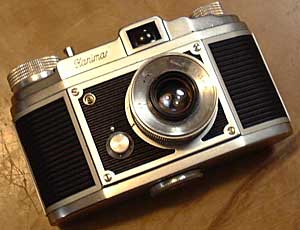


Cameras with Hanimex brand were once sold in Japan, too, but their manufacuring were in various countries, and I had wondered what kind of company it is. According to a book, it is an Australian company and was " Mr. Hannes's import and export company", and asked manufacturers to produce cameras with its brand and sold them in Australia, and later in other countries, too. This Hanimar camera is from the earliest days and manufactured by Finetta company in Germany. The same style camera was sold under the name of Finetta88. I came to like its name "Hanimar" and bought it from a mail order company "Pacific Rim Camera" in US. The on-line catalogue of the web page of this company is very interesting and those cameras probably never sold and bought in Japan are listed. For example it goes like this, "Shutter stuck, Lens helicoid is very hard to turn, A few scratches on the lens, else Excellent"! This Hanimar was rated as "Excellent-", but it was according to this company, so I wondered what it is like. But in reality it was very clean one.
Its specs are not very special, 35mm format, no range finder, no exposure meter, shutter speed B/25/50/100/250, with synchro contact (probably M). An interesting point is that it has a behind the lens shutter and the lens can be exchanged. It was with "Finetar" lens (45mm f2.8), and telephoto lenses were also sold. The mount is bayonet style, but without spring nor stopper and the lens stops there just by friction! Exchange lenses from Hanimex are often called "Hanimar", but in this case the name given by the manufacturer is used. When you remove four screws on the corners of the lens mount board, the shutter mechanism is fully accesible. The shutter is self-cocking but the spring has become week and you must hold the camera up-side-down when you charge the shutter. It needs the help of the gravity.
 |
 |
| Shutter, closed | Shutter, open (the right-hand side is still closed with the blade, may be because of poor manufacturing precision) |
 |
| Back and bottom is removed. On upper left, you see the lens with mount-side up. |
When you turn the dial on the bottom clockwise, the bottom and the back is removed. The pressure plate remains with the body like in the Rollei 35. Usually in a 35 mm cameras, there are sprocket gears which fits holes on the sides of the film and the film advance is detected mechanically by the turn of the gear, enabling a fixed length of the film is wound each time. But in this camera there is no sprocket gears and the rotation angle of the winding knob is fixed. As you wind film, the diameter of the drum gets thicker, resulting in wider spacing between frames on the film. Probally to reduce this, the winding drum is designed to be very thick, resulting in thick body.
 |
| Seen from above. Logo on the finder says, SARABER (founder's name) and GOSLAR (name of the city where the factory was) |
 |
| Proof of its birth. Upper left is the film cartlidge stopper, manually operated. |
When seen from above, it has a very thick shape. It is a bit bulky but good to hold. The leatherett is not leather but vinyl with herring bone pattern. Not very cheap looking and nice. The finder is simple one and, of course, without a bright flame, but it shows a litte wider than the real frame and the outside is tinted gray (see the image below). It is unique and good looking. The winding knob and rewinding knob are made of alminum and the lens barrel is also seems to be of alminum. It easily gets shiny when you polish. In most of the cameras, there is a clutch to prevent the wound film gets loose, and this clutch is released when you rewind the film, but in this camera there is no clutch and you can rewind anytime.
I did not expect the quality of the picture, but to my surprise, it gave good images. Judging from its name and quality, the lens may belong to the Tessar family, and it made crisp images. When the diaphragm is opend the backgroud out focus becomes whorl-like. What the telephoto lenses are like?
 |
| Image of the finder |
To the homepageÅETo the Camera History